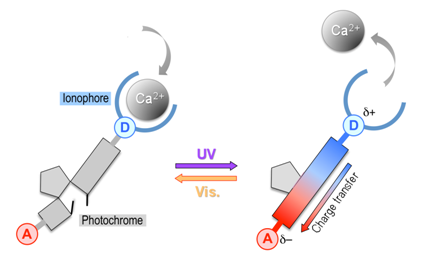
The synthesis and characterisation of a novel Reversibly Photoswitchable Chelator (RPC) of calcium ions, designed as a stepping stone towards producing pulses of calcium concentration in an aqueous environment, is reported. This RPC is constituted of a photochromic diarylethene core connected on one side to a BAPTA (1,2-bis(2-aminophenoxy)ethane-N,N,N’,N’-tetraacetic acid) calcium chelator and, on the other side, to an electron-withdrawing group. The operation principle consists in photoswitching on and off an intramolecular charge transfer between one nitrogen atom of the BAPTA moiety and the electron-withdrawing group, thereby modulating the chelating affinity of BAPTA for calcium ions. Solubility of the compound in a partially aqueous solvent was achieved by grafting a short PEG (polyethylene glycol) tail to the electron-withdrawing group. A reduction of the affinity for calcium ions upon photoswitching by a factor of 3–4, in the hundred nM range of dissociation constant, is reported and constitutes a proof of concept of this type of RPC.

References:
A photochromic calcium chelator is reported to reversibly reduce its affinity for calcium upon photoswitching in aqueous media.
Nadia Dozova,Guillaume Pousse, Bogdan Barnych, Jean-Maurice Mallet, Janine Cossy, Bernard Valeur, Pascal Plaza
J. Photochem., 2018, 360, 181
DOI:10.1016/j.jphotochem.2018.04.029
A novel diarylethene-based photoswitchable chelator for reversible release and capture of Ca2+ in aqueous media
